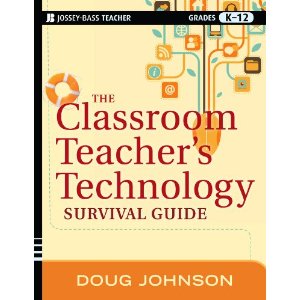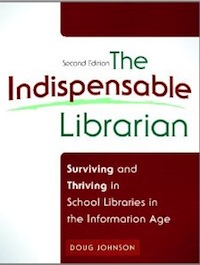The Neglected Side of Intellectual Freedom
The neglected side of intellectual freedom
Head for the Edge, March/April 2013
Doug Johnson <doug0077@gmail.com>
High school student Emily is increasingly concerned over environmental issues in her community and plans to write her senior thesis on this topic . There is an active “green” movement organization in her community that uses Facebook to communicate. Her school blocks Facebook.
Seventh-grader Juan and his friends are having a great time using the iPad to create and edit videos. They think their last production about school bullying would be helpful to other students, but their school blocks YouTube.
Ms. Spenser’s latest professional journal included an article about peer review as a powerful means of helping writers improve their work. But when she inquired about getting GoogleDocs for her fifth grade class to facilitate sharing and commenting on documents online, she was told that GoogleApps was blocked at the elementary level.
We are in a golden age of self-publishing. The tools for sharing ideas and creative efforts through text, photos, movies, and sound have never been easier or more powerful. Unless one is Emily Dickinson, most of us who create want to share our work and get reactions to it. Studies show that the broader the audience, the higher the level of concern students have about the quality of their productions.
Henry Jenkins and others use the term “participatory culture” and express a concern that students who do not master collaboration-enabling technologies will not be able to fully engage in modern cultural and political life. Jenkins writes:
Our goals should be to encourage youth to develop the skills, knowledge, ethical frameworks, and self-confidence needed to be full participants in contemporary culture. … A growing body of scholarship suggests potential benefits of these forms of participatory culture, including opportunities for peer-to-peer learning, a changed attitude toward intellectual property, the diversification of cultural expression, the development of skills valued in the modern workplace, and a more empowered conception of citizenship. 1
Yet as the examples above suggest, many schools make great efforts to keep students (and staff) from sharing their ideas online. Blocking blogs, wikis, social networking venues, and photo/video sharing tools is considered necessary if children are to be “protected.”
My concern is that in our professional efforts to prevent censorship, we are focusing so completely on assuring access to the ideas of others that we neglect the other side of intellectual freedom: the right for all to express their own ideas, information, and art.
Article 19 of the Universal Declaration of Human Rights states: Everyone has the right to freedom of opinion and expression; this right includes freedom to hold opinions without interference and to seek, receive and impart information and ideas through any media and regardless of frontiers. 2 Intellectual freedom includes having the right to create and disseminate information and opinions as well as having the right to access the intellectual products of others.
Given the difficulty and exclusivity of publishing in print (primarily books, newspapers, and magazines) prior to online publishing, the expressive side of the intellectual freedom coin has been largely ignored by school librarians and teachers. But given the increased importance of social networking, the availability of Web 2.0 tools, the realization that knowledge creation is a valuable skill, and the growing recognition of creativity as a primary means of securing a place in the contemporary workforce, all educators (especially librarians) should be advocating for students’ rights to be read, heard, and viewed.
Much of the fear associated with today’s Internet is less about what students will find on it and more about what students will post to it. To some degree these concerns are justified - contact with dangerous strangers, cyberbullying, and online reputation damage are all negative consequences of the ignorant or malicious placement of information, ideas and opinions online. Digital citizenship training needs to address these safety issues.
But there is also a genuine, if not as immediate or well-publicized, danger in preventing students from accessing the tools needed to build and share digital portfolios of original work, to participate in collaborative online learning experiences, to communicate with global experts and fellow students, and to use Web2.0 tools to do primary data collection as a part of research projects. The modern learner needs to share his or her ideas, receive feedback about them, participate in discussions surrounding school topics, and use online tools for collaboration. Schools that block or limit the tools that make publication and communication possible for students are also blocking and limiting educational opportunities.
The library profession is slowly acknowledging that our battle over student rights to access to digital information sources is as important as our battle over student rights to access print resources. (AASL now has a Banned Websites Awareness Day.) But the battle ground is shifting again.
Librarians, are we ready to fight for students’ rights not just to access information, but to produce it as well? Get ready - this will be the real intellectual freedom battle for our kids this decade.
1. Jenkins, Henry. “Confronting the Challenges of Participatory Culture” MacArthur Foundation, 2006 <http://tinyurl.com/jenkinspc>
2. Wikipedia <http://en.wikipedia.org/wiki/Intellectual_freedom>




